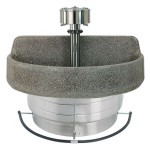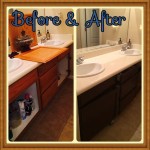How to Caulk a Bathroom Vanity: A Comprehensive Guide
Caulking a bathroom vanity is a crucial step in ensuring its longevity and preventing water damage. A bead of caulk seals the gaps between the vanity and the wall, the countertop and the vanity base, and around the sink, preventing moisture from seeping into vulnerable areas. Moisture intrusion can lead to mold growth, wood rot, and structural damage, ultimately resulting in costly repairs. Properly applied caulk creates a watertight barrier, contributing to a clean, professional finish and extending the life of your bathroom vanity.
This article provides a detailed, step-by-step guide on how to effectively caulk a bathroom vanity, covering everything from preparation to application and cleanup. By following these instructions, homeowners can achieve professional-looking results and protect their investment.
1. Gathering the Necessary Materials and Tools
Before embarking on the caulking process, it's essential to gather all the necessary materials and tools. Having everything readily available will streamline the process and minimize interruptions. The required items include:
*Caulk: Choose a high-quality, mildew-resistant caulk specifically designed for bathroom applications. Silicone caulk and acrylic latex caulk are both suitable options. Silicone caulk offers superior water resistance and flexibility, making it ideal for areas exposed to frequent moisture. Acrylic latex caulk is easier to apply and clean up, and it can be painted, providing a more customizable finish.
*Caulk Gun: A caulk gun is necessary for dispensing the caulk from the tube in a controlled manner. Opt for a smooth-rod caulk gun for more precise application. These offer better control and reduce caulk overflow typically associated with ratchet style guns.
*Caulk Removal Tool or Utility Knife: If removing existing caulk, a caulk removal tool or a utility knife is essential. A caulk removal tool is specifically designed for this purpose, featuring a contoured blade that conforms to the shape of the caulk bead. A utility knife can also be used, but exercise caution to avoid damaging the surrounding surfaces.
*Scraper or Putty Knife: A scraper or putty knife is useful for removing stubborn caulk residue or smoothing out uneven surfaces.
*Cleaning Supplies: Cleaning supplies are necessary for preparing the surfaces before caulking. These include a cleaning solution (such as a mild soap and water mixture or a specialized bathroom cleaner), a scrub brush or sponge, and clean rags.
*Painter's Tape: Painter's tape helps to create clean, straight lines and protect surrounding surfaces from caulk smudges. Choose a high-quality painter's tape that is specifically designed for delicate surfaces to prevent damage.
*Caulk Smoothing Tool or Finger: A caulk smoothing tool or a gloved finger can be used to create a smooth, professional-looking caulk bead. A caulk smoothing tool comes in various shapes and sizes, allowing for customization based on the specific application. Using a finger provides a more tactile approach, allowing for greater control over the shape and consistency of the caulk bead. If choosing to use finger, wear gloves to avoid making a mess.
*Paper Towels or Rags: Paper towels or rags are essential for cleaning up excess caulk and spills.
*Safety Glasses: Safety glasses protect the eyes from debris and accidental splashes of caulk or cleaning solutions.
*Gloves: Gloves protect the hands from caulk and cleaning solutions.
2. Preparing the Surfaces for Caulking
Proper surface preparation is paramount to achieving a durable and aesthetically pleasing caulk bead. The steps involved in preparing the surfaces include:
*Removing Existing Caulk: If replacing old or damaged caulk, carefully remove it using a caulk removal tool or a utility knife. Gently score along the edges of the caulk bead to loosen it from the surrounding surfaces. Then, use the caulk removal tool or utility knife to pry the caulk away, working along its length. Be careful not to damage the vanity, countertop, or wall during this process. A heat gun or hair dryer on its lowest setting can also soften and loosen the existing caulk, making it easier to remove.
*Cleaning the Surfaces: Thoroughly clean the surfaces to remove any dirt, dust, grease, or mildew. Use a cleaning solution and a scrub brush or sponge to scrub the areas to be caulked. Rinse the surfaces thoroughly with clean water and allow them to dry completely. For stubborn mildew stains, use a bleach solution (following manufacturer's instructions and safety precautions) or a mildew-specific cleaner.
*Drying the Surfaces: Ensure that the surfaces are completely dry before applying caulk. Moisture can prevent the caulk from bonding properly, leading to premature failure. Use a clean, dry cloth to wipe down the surfaces and allow them to air dry for several hours, or use a hair dryer on a low setting to expedite the drying process.
*Applying Painter's Tape (Optional): For a clean, professional-looking caulk line, apply painter's tape to the surfaces adjacent to the area to be caulked. Position the tape approximately 1/8 inch to 1/4 inch away from the edge of the gap, creating a defined border for the caulk bead. Ensure the tape is firmly adhered to the surfaces to prevent caulk from seeping underneath.
3. Applying the Caulk
Applying the caulk requires a steady hand and a consistent technique. The steps involved in applying the caulk include:
*Preparing the Caulk Tube: Cut the tip of the caulk tube at a 45-degree angle using a utility knife. The size of the opening will determine the width of the caulk bead. A smaller opening produces a narrower bead, while a larger opening produces a wider bead. Puncture the inner seal of the caulk tube using a nail or wire.
*Loading the Caulk Gun: Insert the caulk tube into the caulk gun, ensuring that the plunger is fully retracted. Squeeze the trigger of the caulk gun until the plunger engages the back of the caulk tube.
*Applying the Caulk Bead: Hold the caulk gun at a 45-degree angle to the surface and apply consistent pressure to the trigger while moving the gun along the joint. Apply a smooth, even bead of caulk, ensuring that it fills the gap completely. Avoid applying too much caulk, as it will be difficult to smooth and clean up. Overlapping is key to ensuring a solid, waterproof seal. Move slowly to avoid gaps or air bubbles.
*Smoothing the Caulk Bead: Immediately after applying the caulk, smooth the bead using a caulk smoothing tool or a gloved finger. Apply gentle pressure to the caulk, pressing it into the gap and creating a smooth, concave surface. Remove any excess caulk with a damp cloth or paper towel. A consistent, smooth bead will not only look better but will also provide a more reliable seal.
*Removing Painter's Tape (If Used): If using painter's tape, carefully remove it immediately after smoothing the caulk bead. Pull the tape away at a 45-degree angle to prevent tearing the caulk. Removing the tape while the caulk is still wet will result in cleaner lines.
4. Post-Application Cleanup and Maintenance
Proper cleanup and maintenance are essential for ensuring the longevity of the caulk bead and maintaining a clean bathroom environment. The steps involved in post-application cleanup and maintenance include:
*Removing Excess Caulk: Use a damp cloth or paper towel to remove any excess caulk from the surrounding surfaces. For stubborn caulk residue, use a specialized caulk remover or a mild solvent.
*Cleaning Tools: Clean all tools and equipment with soap and water or a solvent recommended by the caulk manufacturer. This will prevent the caulk from hardening on the tools and ensure that they are ready for future use.
*Allowing the Caulk to Cure: Allow the caulk to cure completely according to the manufacturer's instructions. This typically takes 24 to 48 hours. Avoid exposing the caulk to water or moisture during the curing process.
*Regular Inspection: Regularly inspect the caulk bead for signs of damage, such as cracks, gaps, or mildew growth. Replace the caulk as needed to maintain a watertight seal.
By following these steps, homeowners can effectively caulk a bathroom vanity, preventing water damage and ensuring a long-lasting, aesthetically pleasing finish. Remember to prioritize safety and take the time to prepare the surfaces properly for optimal results.

Here S How To Caulk Around Bathroom And Kitchen Fixtures

How To Caulk Bathroom Counter With Dap Remove Old Silicone Desolvit
How To Re Caulk A Bathroom Sink Ifixit Repair Guide

Should You Caulk Around A Bathroom Vanity Bathtubber

Person Applying New Caulk Around Bathroom Sink In 2024 Caulking Tips

How To Clean Remove Reapply Caulk In Kitchens And Bathrooms

How To Caulk A Bathroom Sink

How To Caulk Like A Professional The Home Depot

How To Refinish Bathroom Vanity Top With Diy Resin Thediyplan

Choosing The Best Caulk For Bathroom Sink Pep Up Home
Related Posts







